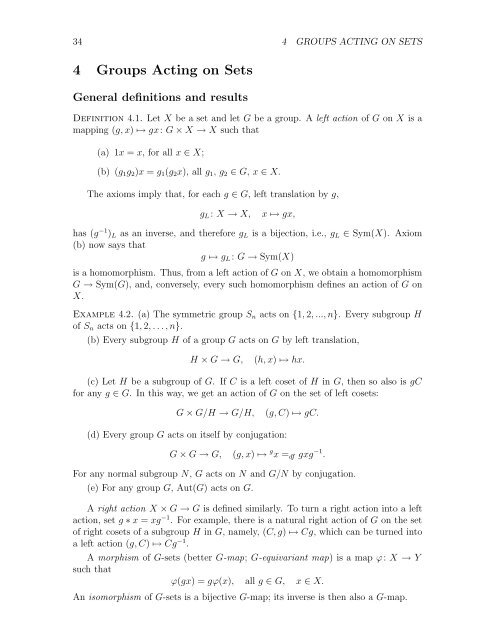Milne - Group Theory.. - Free
Milne - Group Theory.. - Free
Milne - Group Theory.. - Free
You also want an ePaper? Increase the reach of your titles
YUMPU automatically turns print PDFs into web optimized ePapers that Google loves.
34 4 GROUPS ACTING ON SETS<br />
4 <strong>Group</strong>s Acting on Sets<br />
General definitions and results<br />
Definition 4.1. Let X be a set and let G be a group. A left action of G on X is a<br />
mapping (g, x) ↦→ gx: G × X → X suchthat<br />
(a) 1x = x, for all x ∈ X;<br />
(b) (g 1 g 2 )x = g 1 (g 2 x), all g 1 , g 2 ∈ G, x ∈ X.<br />
The axioms imply that, for each g ∈ G, left translation by g,<br />
g L : X → X,<br />
x ↦→ gx,<br />
has (g −1 ) L as an inverse, and therefore g L is a bijection, i.e., g L ∈ Sym(X). Axiom<br />
(b) now says that<br />
g ↦→ g L : G → Sym(X)<br />
is a homomorphism. Thus, from a left action of G on X, we obtain a homomorphism<br />
G → Sym(G), and, conversely, every such homomorphism defines an action of G on<br />
X.<br />
Example 4.2. (a) The symmetric group S n acts on {1, 2, ..., n}. Every subgroup H<br />
of S n acts on {1, 2,...,n}.<br />
(b) Every subgroup H of a group G acts on G by left translation,<br />
H × G → G,<br />
(h, x) ↦→ hx.<br />
(c) Let H be a subgroup of G. If C is a left coset of H in G, then so also is gC<br />
for any g ∈ G. In this way, we get an action of G on the set of left cosets:<br />
G × G/H → G/H,<br />
(g, C) ↦→ gC.<br />
(d) Every group G acts on itself by conjugation:<br />
G × G → G, (g, x) ↦→ g x = df gxg −1 .<br />
For any normal subgroup N, G acts on N and G/N by conjugation.<br />
(e) For any group G, Aut(G) actsonG.<br />
A right action X × G → G is defined similarly. To turn a right action into a left<br />
action, set g ∗ x = xg −1 . For example, there is a natural right action of G on the set<br />
of right cosets of a subgroup H in G, namely,(C, g) ↦→ Cg, which can be turned into<br />
a left action (g, C) ↦→ Cg −1 .<br />
A morphism of G-sets (better G-map; G-equivariant map) isamapϕ: X → Y<br />
suchthat<br />
ϕ(gx) =gϕ(x), all g ∈ G, x ∈ X.<br />
An isomorphism of G-sets is a bijective G-map; its inverse is then also a G-map.

















